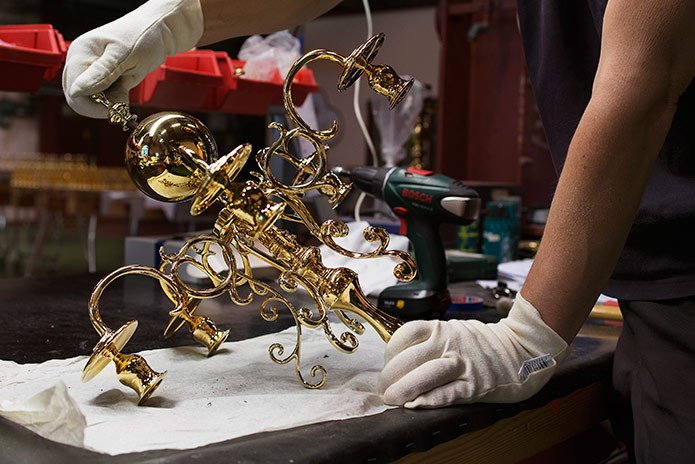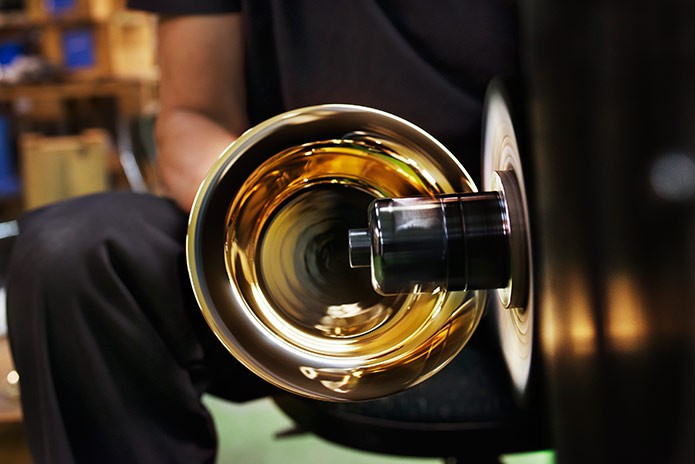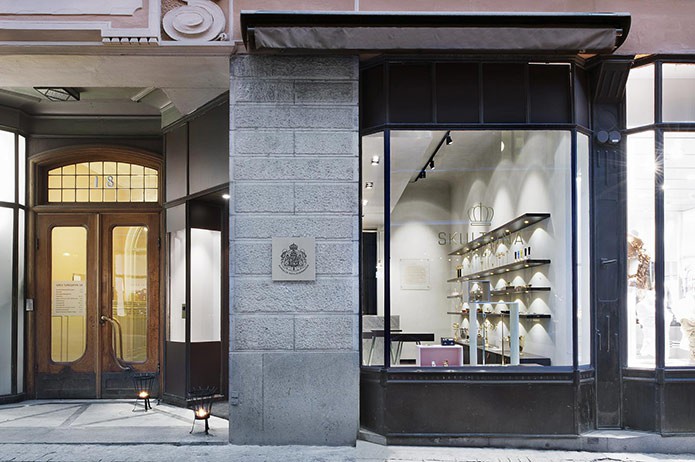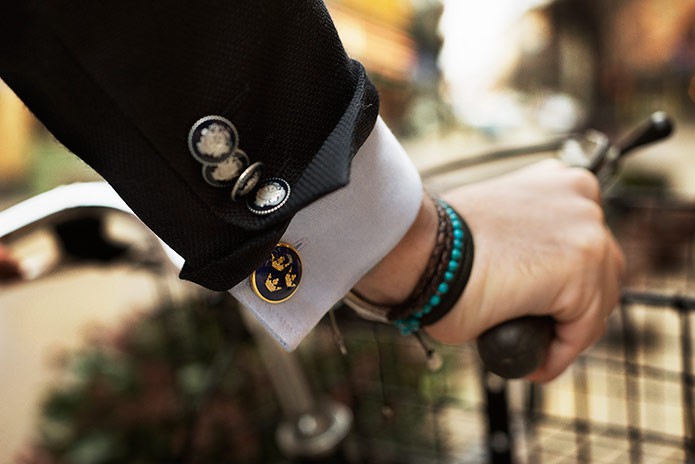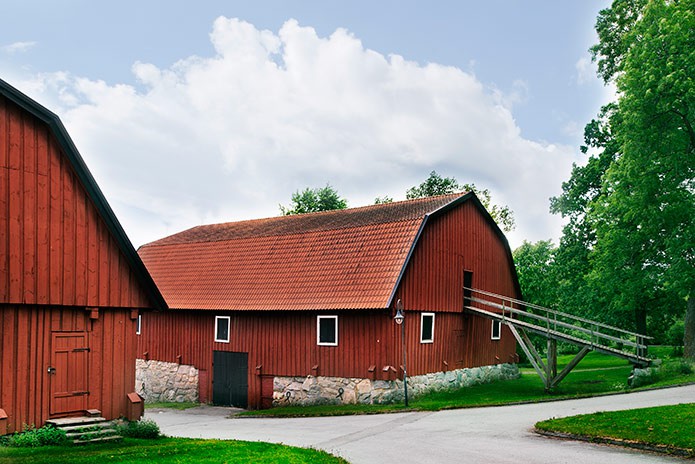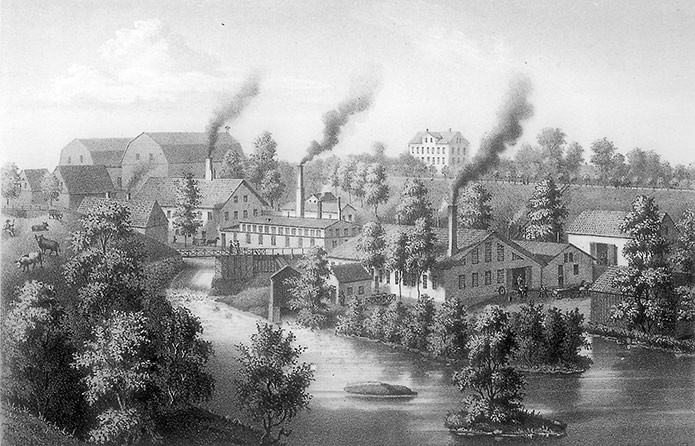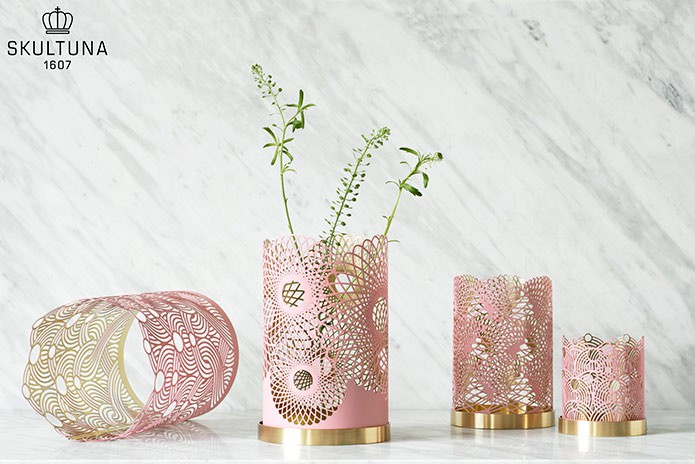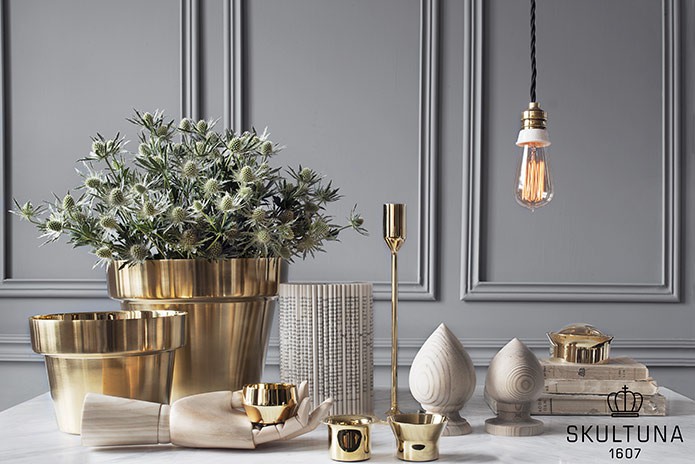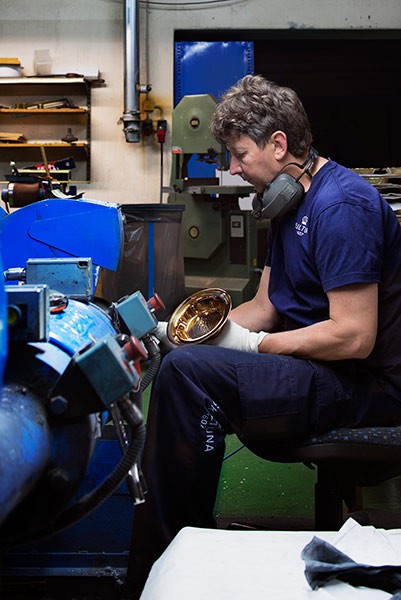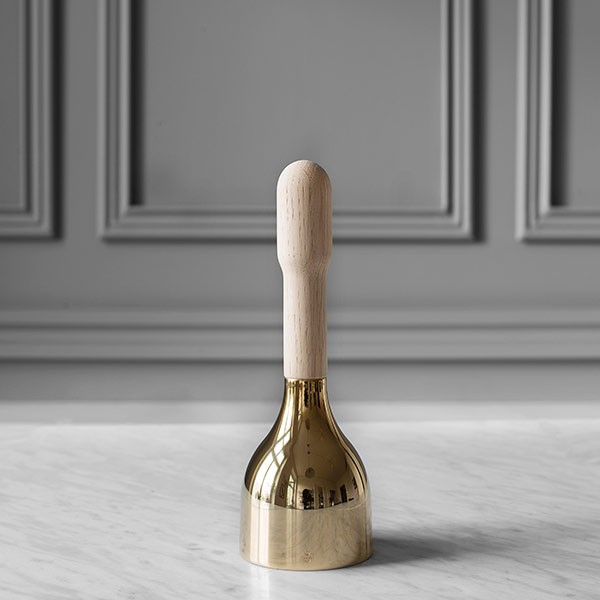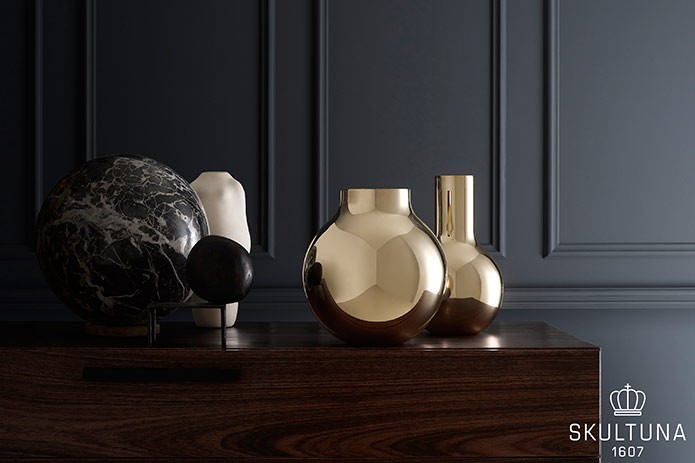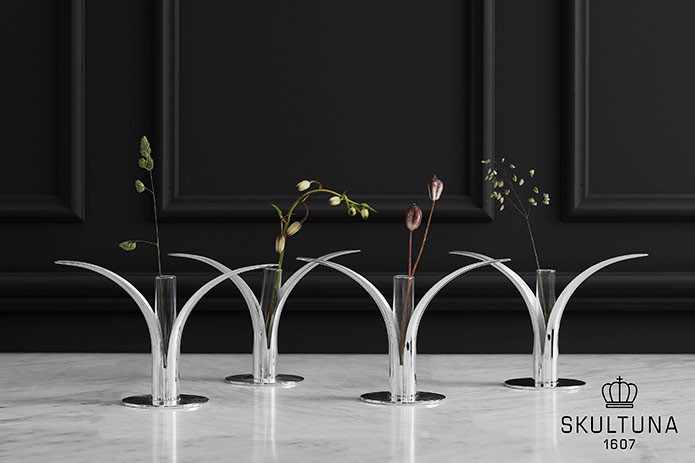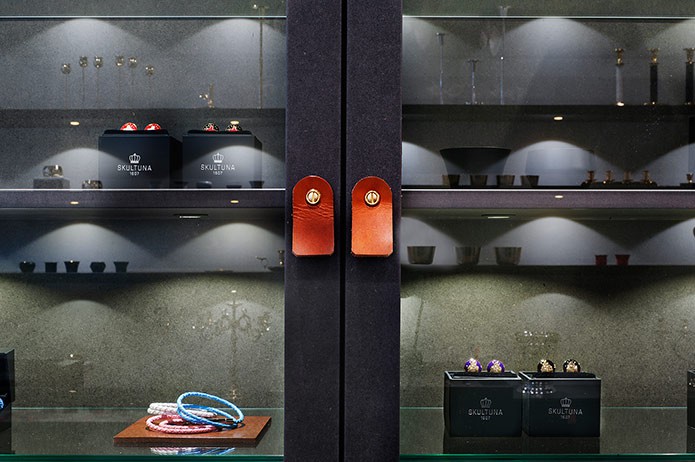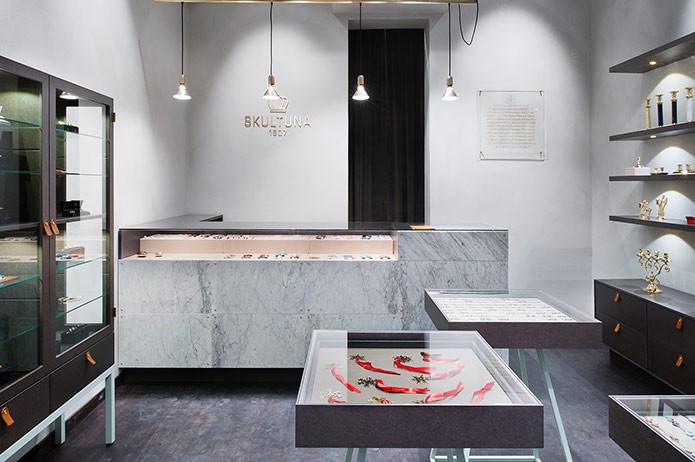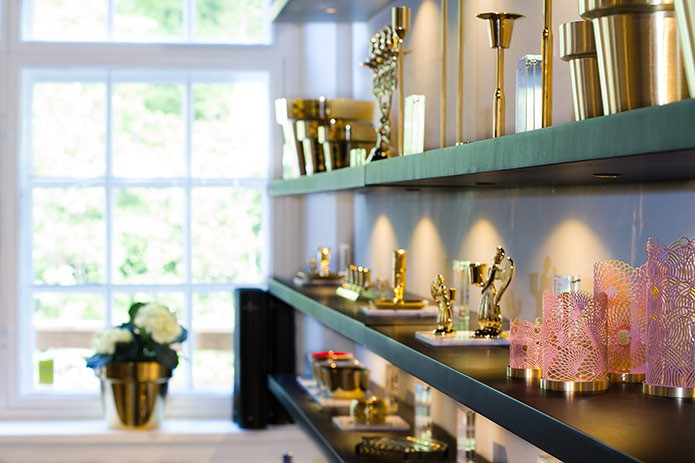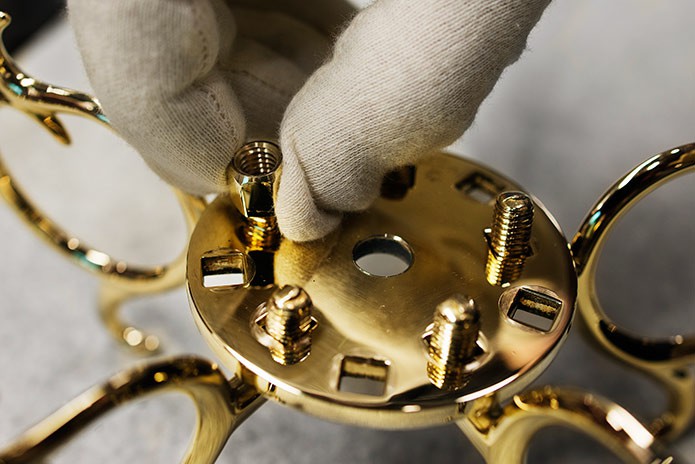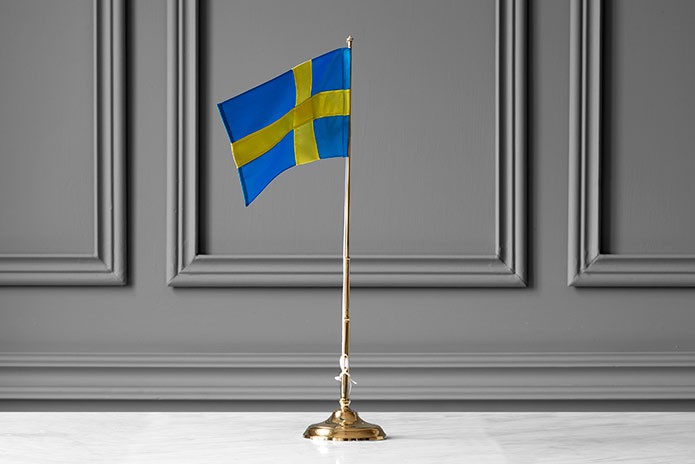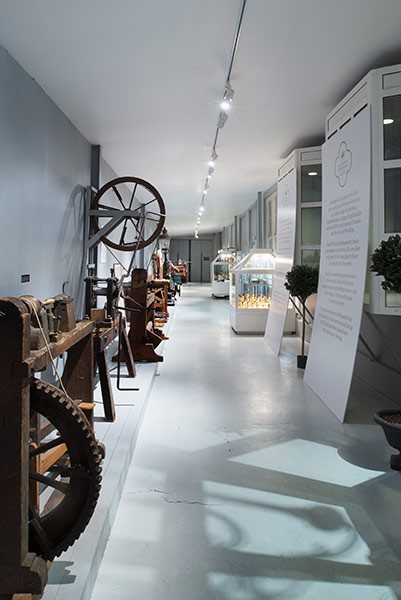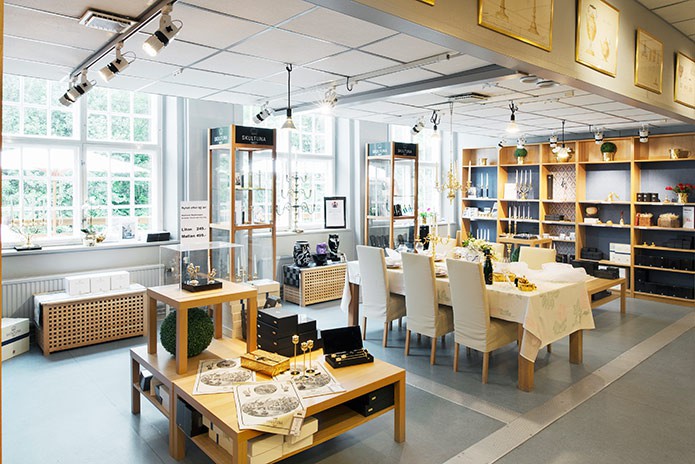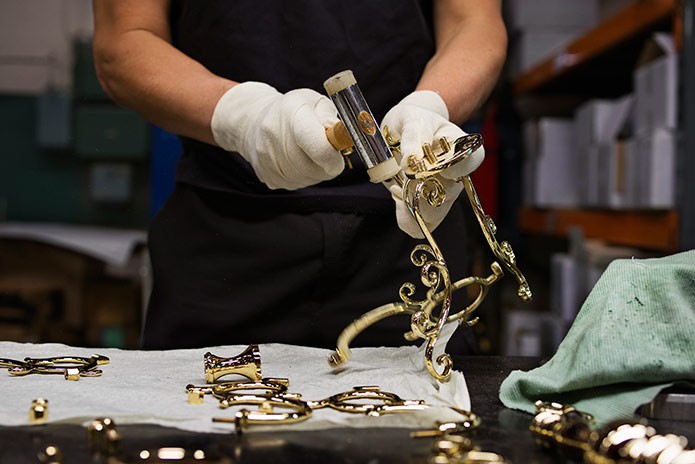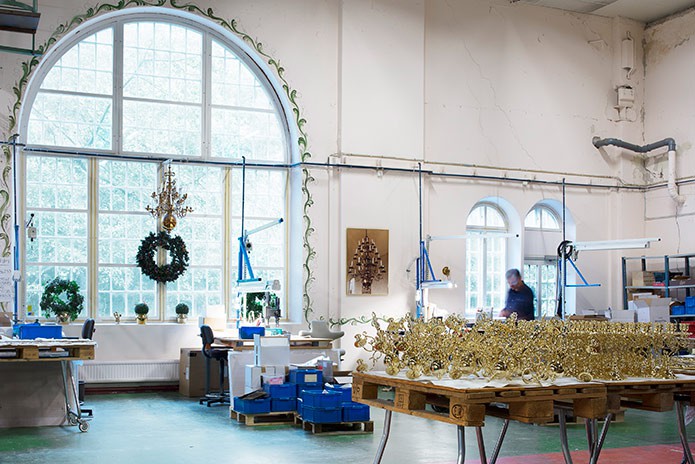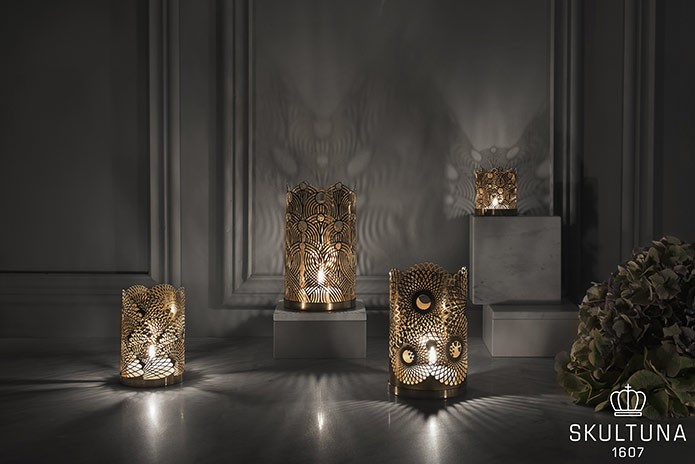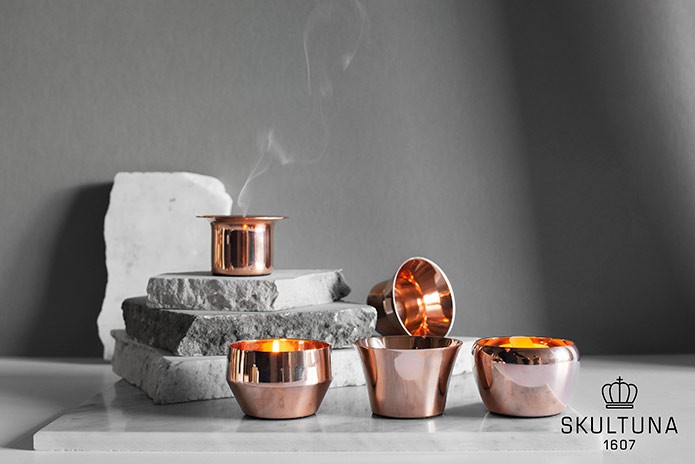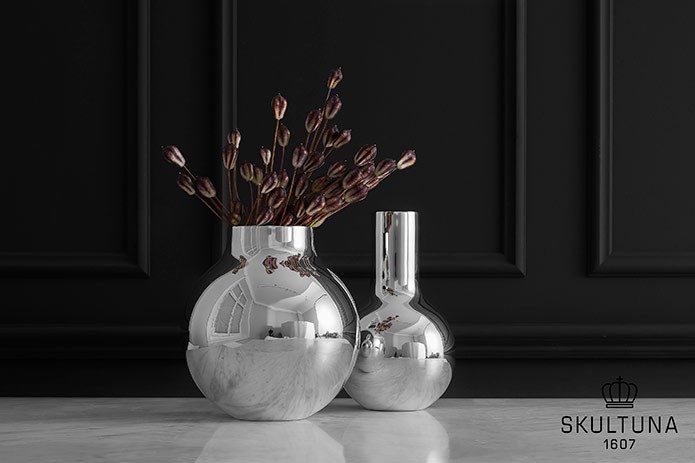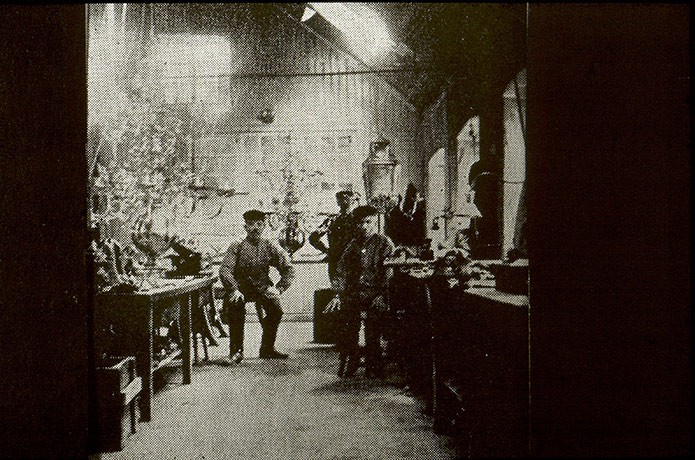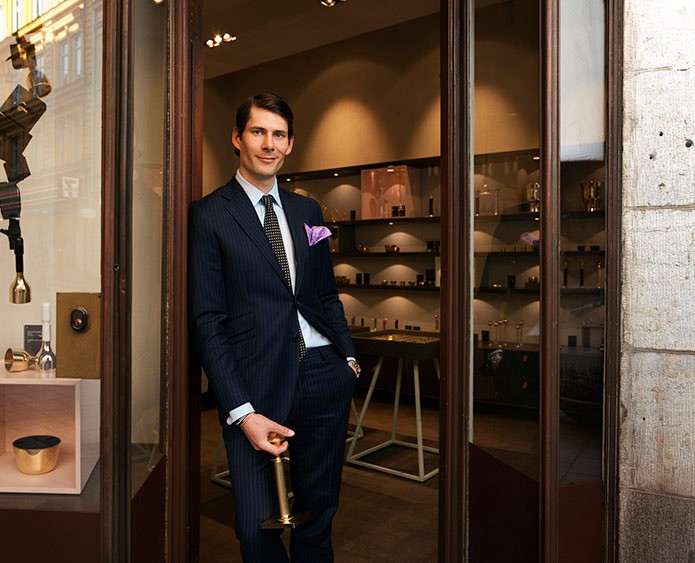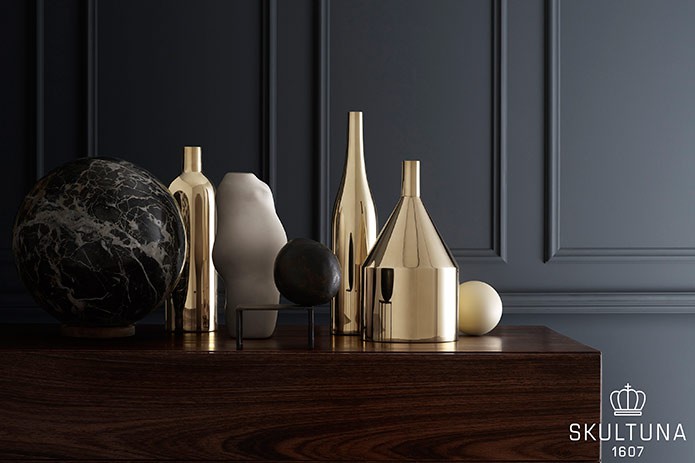
Ever since the then King of Sweden founded a brass foundry at Skultuna on the north-western side of Lake Mälaren, 65 miles from Stockholm, over 400 years ago, Skultuna has been designing and crafting the finest quality brass objects for both the domestic and increasingly international markets.
Skultuna’s commitment to bold design, combining the classic with the contemporary, has revitalised this ancient company’s fortunes, reinvigorating brass, a traditional material, into modern day iconic design masterpieces along with premium everyday objects. Each Skultuna item is designed and crafted to last, and even outlast their discerning customers; in fact, ‘tomorrow’s antiques’ is a phrase Skultuna uses to describe their brass pieces.
The continued outward-looking focus on design styles, working with the cutting edge of Swedish, Scandinavian and increasingly international designers, together with the reverence towards the raw material and a careful curation of craft, has meant that Skultuna’s collaborations and resultant collections are marriages of form and function in both home and fashion accessories that continue to appeal to both a traditional and modern audience.
Merchant & Makers recently visited Skultuna’s concept store in Stockholm to talk with CEO Viktor Blomqvist, who provides an illuminating insight into the timeless classic that is Skultuna…
Firstly, for those readers who aren’t familiar with Skultuna, please can you explain what you do and provide some historical context?
Skultuna produces objects of the highest quality, including home and fashion accessories, mainly from brass. The company was founded by King Karl IX of Sweden as a brass foundry back in the early 17th Century in a bid to reduce imports of brass and increase revenues from exports, at a time when Sweden had become indebted to the Hanseatic League. Initially, the focus was more on bulk brass, although the decorative side has always been a part of the business, such as the production of chandeliers. By the late 19th Century, the decorative side took over completely, primarily as a result of industrialisation taking hold in Sweden. Sweden’s industrial revolution started later than in England – Stockholm only started to be built up around 1890 – and with industrialisation, Skultuna started made items suitable for the new houses and apartments being constructed, working with a number of great industrial designers.
Today, Skultuna is a very modern and forward-looking company – we work with renowned designers from across Europe, we supply leading department and boutique stores across the world, and exhibit at the leading international design fairs. However, whilst we see ourselves as an international brand, we are proud of our Swedish heritage; we still maintain our original production facility in the town of Skultuna, where our finishing works are carried out, and which is also a major tourist attraction in Sweden, and we also have flagship and concept stores in the centre of Stockholm.
Can you explain the royal connection?
Skultuna was founded by King Karl IX of Sweden in 1607, yet it was a short-lived ownership, as very soon after founding the company, he was forced to rent out the mill to a local industrialist, as he was effectively bankrupt. It wasn’t long afterwards that Skultuna fell out of the royal estate and into private ownership completely. That said, the company has still been considered as a royal family brand in a way – we were founded by the king and we are still purveyors to this day.
Our previous owner was considered a personal friend of the royal family, and there are still close ties; members of the royal family are still loyal customers, and we commissioned an official wedding series cufflink in honour of Crown Princess Victoria and Prince Daniel’s wedding in 2010 to support their Wedding Foundation charity.
Is there anything about the immediate landscape and environment around the town of Skultuna that made it ideal for the production of brass, as we are intrigued as to why King Karl IX chose the location he did, over 100 kilometres from his residence in Stockholm?
Skultuna is located a few kilometres north of the harbour at Västerås, which is situated on the north-western shore of Lake Mälaren – the closest point that you can get to the great copper mine, Falun Mine, by water from Stockholm. Falun was the biggest copper mine in the world at the time and produced two thirds of Europe’s copper needs; it also had a productive silver mine.
The war of independence from Denmark was very expensive and the country was effectively bankrupt. The only resource that the country had to generate income was the international sale of brass – it was the country’s Ericsson of the day. It’s impossible to overstate how important and critical the mines at Falun were to Sweden’s economic history, as well as providing its imperial-like self-esteem. Arguably, we still ride that today in many ways.
The iconic deep red-coloured wooden houses and barns you find widespread across Sweden stems from the copper oxide pigment that was a by-product from the copper mine at Falun, and it was seen as patriotic to paint houses in this “falu-red” paint.
The majority of the brass produced at Skultuna from the refined copper ore was made into rods and then sold to international markets, such as Germany and England. The brass was shipped through Stockholm, situated at a very strategic point on the eastern side of Lake Mälaren; a place where all export tolls could be controlled.
As to the precise location of the brass foundry, aside from the proximity to the copper mine, and the harbour at Västerås, Skultuna was chosen for its abundance of trees to make charcoal, as to melt the quantity of brass being produced required a lot of wood. Another factor was the availability of a stream – Svartån brook – running through the factory for water power.
Brass is such an ancient material, and to some, especially in the UK, is associated with classic instruments, tools and door furniture. However, Skultuna seems to have been a magnet to contemporary and modernist designers keen to work with brass – why do you think Skultuna has so successfully bridged the gap between classic & contemporary?
We’ve been very good at this over the past 15 years, but before then there were huge gaps. The reality is that the previous owners of company didn’t really believe in modern design, and there were only a few product lines that you could say had any aspect of modernism within them; the remainder were very much traditional items focussed on classical and neo-classical designs which were very popular in the early 20th Century. Sales were decreasing each year, and before the new owner came in, the company had no future. It was evident that the company had to be relevant to younger crowds, and that’s when we started working with international designers developing more contemporary pieces.
Can you shed some light as to why brass as a material is so versatile?
Brass is relatively easy to work with; being an alloy of copper and zinc, the zinc makes it slightly more flexible and so easier to work. Brass can be both cast and spun, in fact, many of our items, such as flower pots, are spun from sheet brass, which is a very old production method dating back to when Skultuna was established over 400 years ago, and is a technique that allows the craftsmen to make large round three dimensional objects from sheet metal.
The unique golden hue of brass, and its reflective qualities, have traditionally lent the metal to being ideally suited to candlelight. Highly polished brass is very reflective and doesn’t melt, and we have perfected a special way of polishing brass here at Skultuna, and can achieve an incredible finish.
The one slight downside with brass is that oxidation accumulates over time on the surface. That’s why our popular ‘Ring My Bell’ dinner bell – a modern version of a classic school bell from 200 years ago – has a wooden handle to avoid touching the brass, which speeds up the oxidation process.
Many designers, past and present, have been attracted to working with Skultuna. They have all had different inspirations, influences, specialisms and techniques, resulting in an eclectic yet harmonious collection of pieces. To what extent do you influence design and price?
We’re always interested in finding new ways to work with brass to create decorative, useful objects. Half of the collection has been created by designers without any steering from us, and the other half we have steered them to a degree. We don’t really set out with the objective to work to a particular price though.
Your website uses the lovely juxtaposed phrase ‘tomorrow’s antiques’. Can you elaborate a little on what the essence of that means?
We try to make everything of a quality that should be everlasting, so items can be passed down through the generations – timeless classics. On the design side, we want to be at the forefront of design. We occasionally do some crazy and spontaneous things, but our designs are regarded as generally conservative, or rather a conservative slant of modernism, which we believe will always be sought after.
You have customers all around the world now; why do you think you have developed such an international appeal?
The main factor is that people are just a bit bored of international brands; the sort of brands you see everywhere. Finding the small, select premium brands – those that you can’t find everywhere – are increasingly sought after by discerning shoppers. That is the interesting thing about shopping, especially with the internet, as people can explore brands that they wouldn’t otherwise have known about.
It didn’t just happen straightaway though – we’ve gradually got on the radar of people, whether through advertising in World of Interiors, attending Paris fairs, or creating noise on social media, and we now stock some of the world’s finest home accessories shops. The momentum has been like a snowball in recent years. I’d say that we get approached by international retailers to stock products at least once a day, as far afield as Brazil and Korea.
There is a real appreciation for Skultuna within Sweden, and your designs have been taken to heart, by young and old alike. What is the key behind Skultuna’s success as a contemporary classic, within Sweden especially?
There’s a significant difference in design tastes between Sweden and the UK, for instance. Whereas in Britain, design tastes are still quite traditional, with modernism being a sub-culture, in Sweden it is the other way around – it’s almost completely modernistic, with probably less than 5% of Sweden decorated in a classical way. The vast majority of people have sold their antique furniture and started afresh with white walls and Ikea, including a lot of modernistic design classics and accessories on top of that, from companies such as Skultuna.
Design is a new religion in Scandinavia, and it’s commonplace for young girls to mention the names of twenty different designers, detailing the they’ve done, all from that they’ve read about in magazines. Both Sweden and Denmark are big markets for modern design, and Skultuna has benefited greatly from this. It’s hard to convey just how successful Skultuna has been in Sweden, but if you were to go to any small town, you could easily have three retailers stocking Skultuna.
Historically, your client base has included the higher echelons of society, royalty, and so on. Is there a typical Skultuna customer today, and if so, how would you describe them?
Whilst our client base has included royalty and the like, we have never really considered ourselves as a luxury brand. We’ve perceived more as a premium brand amongst Swedes, largely because brass, which we’re renowned for, is an affordable metal; people used to refer to brass as ‘poor man’s silver’, and brass objects were affordable, unlike silver, which was the preserve of nobility.
For the majority of people, the connection with silver has been lost in Sweden; they have lost the feeling for material – younger people can’t get in at the price level, and don’t have any relationship to that material. Brass is, however, accessible, hence one of the reasons for our enduring popularity – the Swedish are very proud of their Skultuna objects.
Your factory at Skultuna is a major tourist attraction in Sweden, why do you think it is such an iconic place to visit?
Skultuna is very dear to many Swedes; the brassworks have been around for so long – over 400 years in the same place! It also helps that Skultuna is situated in a very beautiful valley in the Västmanland province of Sweden, which is a popular tourist destination. We alone get over 150,000 visitors each year to the brassworks.
We have reinvested much of our profits in restoring the historic factory buildings; these include a museum, a café, as well as a range of shops selling goods from a number of famous Scandinavia brands such as Orrefors, Kosta Boda, Målerås and Littala, as well as our own outlet. Whilst our sleek flagship and concept stores are based in Stockholm, it’s very important that the factory shop should look really nice as our heart is there. The tourist attraction is a colossal place, and is in a constant state of upkeep to keep it looking so nice, but we feel it is worth the investment.
Can you talk us through the revival Skultuna has seen since you joined fifteen years ago?
I joined Skultuna straight from University, where I majored in art history and marketing, initially working in sales. The company was going really badly at the time, and the company was down to only 10 employees. The new owner of the company looked at the business very closely and his last roll of the dice was to start afresh with a new management team, and he made me MD as he thought I really understood the business – I have always been interested in brands, products and history.
The first ten years was a period of stabilising the business and slow growth. The past five years, on the other hand, has been a period of rapid growth, whereby we have been growing at a rate of between 20-40% each year; the majority of which has been overseas. We’re now up to 50 employees, so it’s been incredibly fulfilling to see, and be part of, the company’s resurgence.
The key to our success has been making products that the market wanted – it’s all about understanding the market, improving our collections and collaborations with designers. Social media exploded five years ago, and we were in the ‘wave’ when that happened, which has certainly helped.
And as well as Skultuna being synonymous with brass, there has been a diversification into other metals; can you talk us through this side of Skultuna?
It’s market demand that steers us, and hence we’re always open to exploring other ideas. We’ve produced a lot of copper pieces over the years, for instance we produce copper versions of some of our flower pots and candleholders – copper being a really honest metal, and its use is a tribute to the time when Skultuna used to make many different kinds of kitchen utensils in the 19th and early 20th centuries.
As well as the copper mines close to Skultuna, there were also silver mines close by, so we feel that we have an affinity and a right to work in this metal also. We sell a lot of silver-plated items on brass, and even a few sterling pieces. Occasionally, we have produced gold-plated sculptural objects.
Finally, how would you describe what it means to be part of Skultuna?
The more years I put into Skultuna, the humbler I become. Every time I visit the museum, I can almost feel the guys from centuries before me thinking the way I do now – tweaking the lines to make them more saleable and pleasing to the market. There’s a real sense of standing on the shoulders of giants.
Thanks to Viktor Blomqvist for taking time out of his busy schedule to answer our questions. All images courtesy of Skultuna.
http://skultuna.com/

